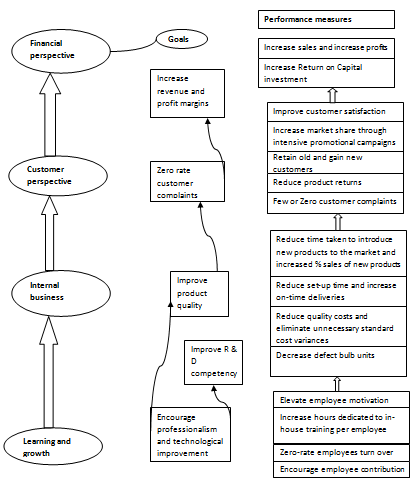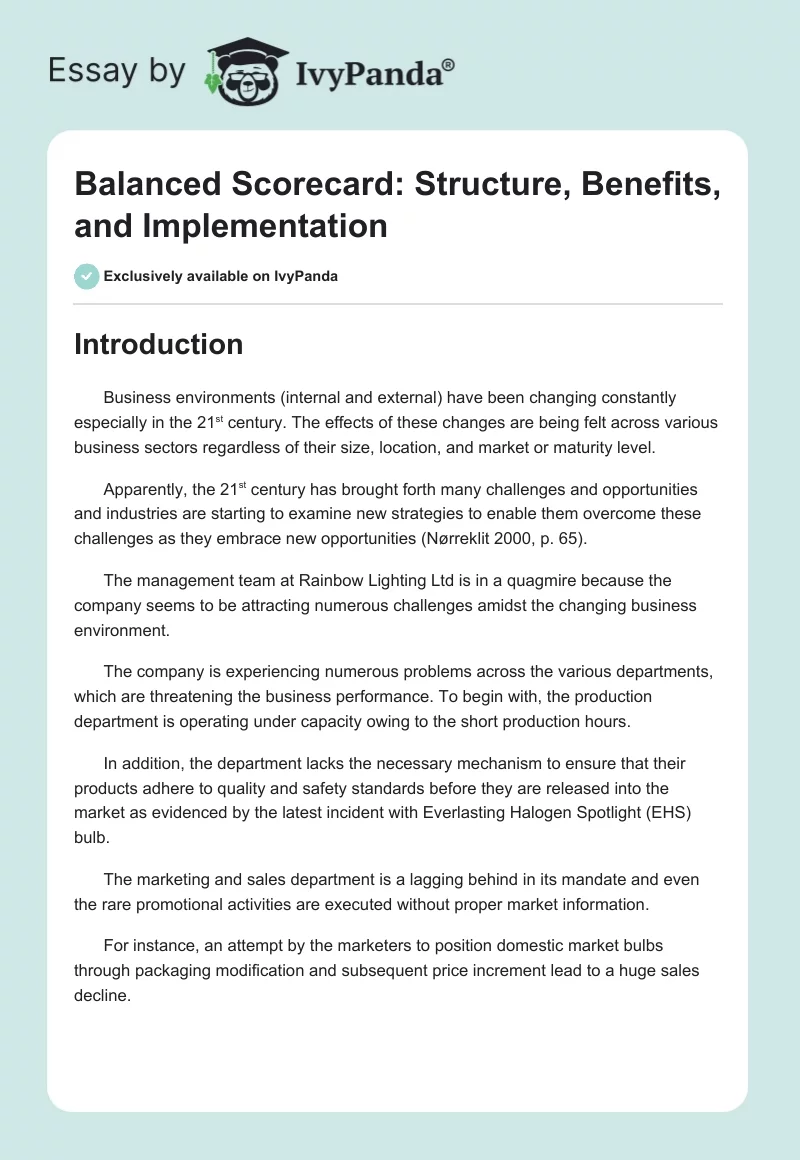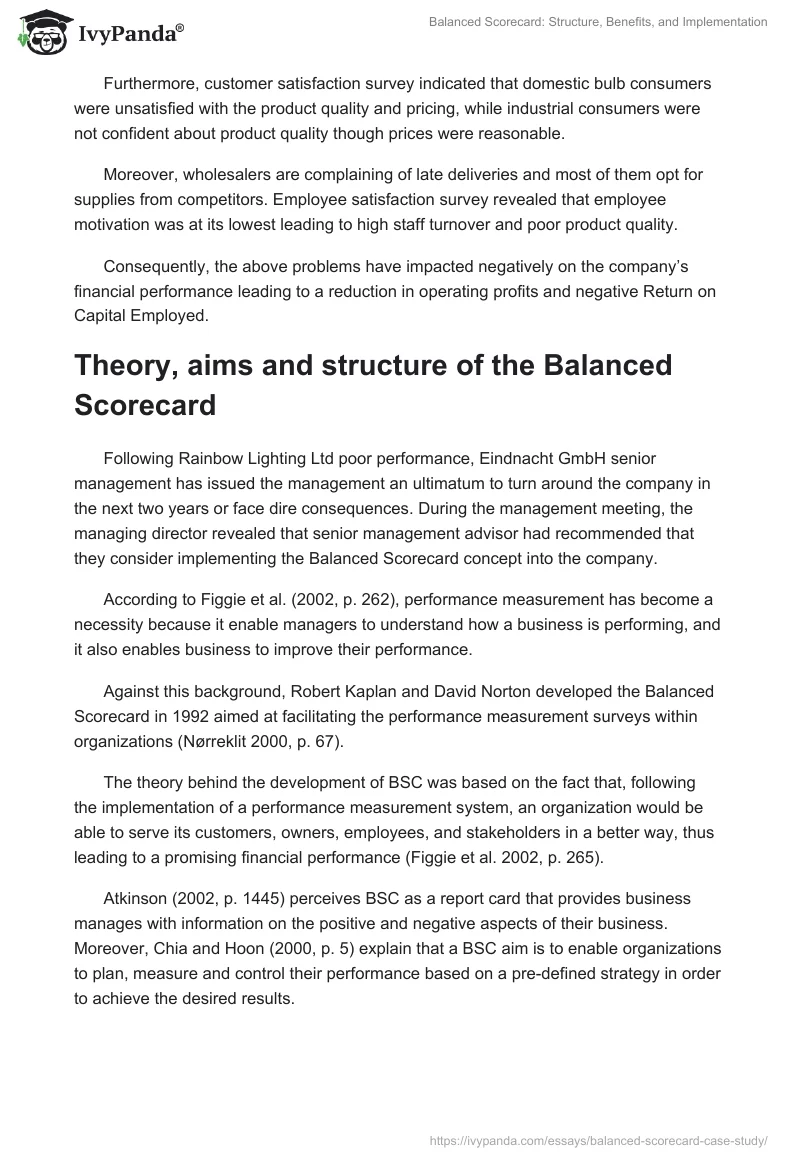Introduction
Business environments (internal and external) have been changing constantly especially in the 21st century. The effects of these changes are being felt across various business sectors regardless of their size, location, and market or maturity level.
Apparently, the 21st century has brought forth many challenges and opportunities and industries are starting to examine new strategies to enable them overcome these challenges as they embrace new opportunities (Nørreklit 2000, p. 65).
The management team at Rainbow Lighting Ltd is in a quagmire because the company seems to be attracting numerous challenges amidst the changing business environment.
The company is experiencing numerous problems across the various departments, which are threatening the business performance. To begin with, the production department is operating under capacity owing to the short production hours.
In addition, the department lacks the necessary mechanism to ensure that their products adhere to quality and safety standards before they are released into the market as evidenced by the latest incident with Everlasting Halogen Spotlight (EHS) bulb.
The marketing and sales department is a lagging behind in its mandate and even the rare promotional activities are executed without proper market information.
For instance, an attempt by the marketers to position domestic market bulbs through packaging modification and subsequent price increment lead to a huge sales decline.
Furthermore, customer satisfaction survey indicated that domestic bulb consumers were unsatisfied with the product quality and pricing, while industrial consumers were not confident about product quality though prices were reasonable.
Moreover, wholesalers are complaining of late deliveries and most of them opt for supplies from competitors. Employee satisfaction survey revealed that employee motivation was at its lowest leading to high staff turnover and poor product quality.
Consequently, the above problems have impacted negatively on the company’s financial performance leading to a reduction in operating profits and negative Return on Capital Employed.
Theory, aims and structure of the Balanced Scorecard
Following Rainbow Lighting Ltd poor performance, Eindnacht GmbH senior management has issued the management an ultimatum to turn around the company in the next two years or face dire consequences. During the management meeting, the managing director revealed that senior management advisor had recommended that they consider implementing the Balanced Scorecard concept into the company.
According to Figgie et al. (2002, p. 262), performance measurement has become a necessity because it enable managers to understand how a business is performing, and it also enables business to improve their performance.
Against this background, Robert Kaplan and David Norton developed the Balanced Scorecard in 1992 aimed at facilitating the performance measurement surveys within organizations (Nørreklit 2000, p. 67).
The theory behind the development of BSC was based on the fact that, following the implementation of a performance measurement system, an organization would be able to serve its customers, owners, employees, and stakeholders in a better way, thus leading to a promising financial performance (Figgie et al. 2002, p. 265).
Atkinson (2002, p. 1445) perceives BSC as a report card that provides business manages with information on the positive and negative aspects of their business. Moreover, Chia and Hoon (2000, p. 5) explain that a BSC aim is to enable organizations to plan, measure and control their performance based on a pre-defined strategy in order to achieve the desired results.
Traditionally, performance measurements have often focused on financial measures while ignoring the contribution of non-financial measures to the organizations performance.
On this note, the BSC model measures performance based on four different perspectives – a financial perspective (return on capital employed, economic value-added, operating income, etc) , an internal business process perspective (employee satisfaction, new product development ), a customer perspective (customer satisfaction, new customer acquisition, customer loyalty, customer profitability etc.), and a learning and growth perspective (skills improvement, IT system overhaul ) (Chia & Hoon 2000,p.2).
Accordingly, the BSC utilizes the various perspectives to achieve a balance between leading and lagging performance measures thereby the managers are able to grasp the negative and positive aspects of an organizations performance Atkinson (2002, p. 1445).
Literature review
Since its inception, the BSC system has gained tremendous popularity with most organizations adopting its tenets globally. Contrastingly, empirical evidence on the impact of BSC and performance systems in general is extremely rare (Atkinson 2006, p. 1442).
The latter author explains that a great number of extant literatures have tended to focus on exploring the shortcomings of traditional performance measurements systems as well as designing alternative measurement methods to overcome this drawbacks (Ahn 2001, p. 455).
As a result, whereas most researchers have carried out empirical studies on design and deployment of existing performance measurement systems, most have eschewed from investing the impact of these systems on the organizations (p. 456).
Benefits of BSC system
Chia and Hoon (2000) carried out a study on BSC procedures, BSC perspectives and implementation among major firms in Singapore. The results of this empirical study established that by adopting BSC systems, firms were able to clarify their vision and implement the necessary mechanisms to facilitate the practice of BSC performance measurement systems (p. 10).
Similarly, Hoque and James (2000) carried out an empirical study among 66 Australian manufacturing companies that had implemented BSC system.
The firms reported that organizational performance which was assessed based on ROI, capacity utilization, sales margin, customer satisfaction and product quality relative to competitors showed a positive improvement and the above parameters exhibited a positive causal-effect relationship (p.12).
Ahn (2001) research was designed as a case study of a strategic business unit which was carried out within a product supplier organization. The above study established that through the implementation of a BSC, firms were able to realize the targeted performance goals.
In addition, BSC was cited to be a comprehensive management tool that enabled the firm to achieve numerous management benefits such as successful strategic communication, effective planning and budgeting of firm’s strategic plans and improved company control (p. 458).
Olson and Slater (2002) administered over 200 questionnaires to senior managers in manufacturing and service firms to establish their recognition of BSC implementation. The respondents in this study affirmed that BSC implementation led to improved performance in financial, learning and growth, internal business process and to a greater extent the customer perspective (p. 15).
Similarly, Papalexandris et al. (2004) study also elicited similar results whereby the implementation of BSC in a Greek software firm had showed considerable progress of financial, customer, learning and growth and internal business perspectives (p. 363). This brief literature review indicates that BSC is a beneficial strategic management tool that enables firms to achieve their performance measurement goals.
It is important to note, BSC has been adopted in numerous business fields including e-business, small and medium size manufacturing firms, IT firms, airport management firms among others, thus the results of BSC benefits can be generalized across most industries (Papalexandris et al.2004, p. 394).
Limitations of BSC
Notwithstanding the numerous benefits associated with BSC measurements, various existing literatures have established great deficiencies associated with this concept. BSC has often been praised for its ability to capture causal-effect interrelations among the financial and non-financial elements and their effect on an organization’s performance.
However, Nørreklit (2000) claims that Kaplan and Norton did not discuss the causal relationships explicitly in their earlier publications (p. 70). In his criticism, Nørreklit (2000, p. 71) pointed out that the causal-effect relationship discussed by Kaplan and Norton does not take into account the aspect of time thus making the interrelations subjective than objective.
In addition, Nørreklit is doubtful about whether the causal interrelations between the various BSC perspectives are ever present in all business situations. For instance, Kaplan and Norton claimed that increased customer satisfaction and loyalty would translate to increased financial revenues.
However, Nørreklit (2000, pp.73-74) disagrees by expounding that such a connection is not always obvious especially in a situation whereby clients demand high quality but make insignificant purchases; thus the organizations end up generating little or not profit at all.
Secondly, BSC has been criticized for its inability to capture business external environment elements such as SWOT analysis, PEST analysis and Benchmarking which are considered vital to operation performance (Simons et al. 2002, p. 56).
Evidently, BSC only consider shareholders and clients, ignores the role of important interest groups such as competitors and their impact on business performance (p.57).
The latter author argues that the fact that BSC structure does not take into consideration important external environment elements is a great shortcoming because businesses do not operate in isolation of elements such as cooperation partners and suppliers (p.58).
On the same note, Kanji and Moura (2002) faulted the BSC top-down approach arguing that it is not ideal methodology mainly because hierarchical decision set-up does not encourage employee participation in decision making (p.20).
This perception can also be supported by Beardwell and Holden (2007), argument that firms that utilize hieratical decision making set-up are likely to experience employee motivational problems leading to reduced productivity (206).
Conditions for implementing BSC
Evidently, Kaplan and Norton have explicitly expounded on methodological execution of a BSC. Their description point out that effective implementation of BSC is only plausible in large companies due to the extensive demand for human resources.
Noticeably, Olson EM, Slater (2002) identifies this methodological demand as a grave shortcoming of BSC in that unstable organizations are unlikely to realize the perceived benefits of BSC (p. 12). However, Figgie et al. (2002) is of the opinion that since Kaplan and Norton did not describe the necessary conditions that organizations ought to fulfill prior to implementing BSC system, hence it must be universally applicable.
Nonetheless, BSC is mostly effective if implemented in organizations that operate in less volatile environments (p. 272). The latter author explains that organizations in highly volatile environment tend to alter their strategies frequently, thus they have to keep changing the BSC perspective measures.
This implies that the said companies are unable to ascertain the effects of BSC measures due the constraints of time. On this note, since Rainbow Lighting Ltd operates in a stable business environment, it is easier to conduct a performance measurement based on BSC perspectives.
Balanced Scorecard for Rainbow Lighting Ltd

From the case study, Rainbow Lighting Ltd senior management has insisted that the firm must record an 18% return on capital employed in the next two years. Consequently, in order to realize increased revenue and profit margins, the management must first focus on achieving high customer satisfaction levels.
Prior studies on customer satisfactions established a directed cause-effect relationship between customer satisfaction, customer loyalty and financial results. This existing literature indicated that whenever an organization cultivates good customer relationship with its clients, their sales are likely to increase leading to increase revenue and profits (Armstrong 2009, p. 122).
On the same note, both domestic and industrial customers are not confident about the quality of bulbs, thus improving product quality will reduce customer complains. Ahn (2001, p. 457) explains that reduced customer complains can be interpreted to mean that customers are satisfied with the product quality.
The relationship between customer satisfaction and customer loyalty has been studied widely, and studies results concur that customer satisfaction cultivates customer loyalty (Seal et al. 2009, p. 126).
In addition, satisfied customers’ acts as product referees through word of mouth advertising, in turn, market share for both domestic and industrial bulbs will expand leading to increased revenue and profit growth.
According to Porter et al. (2008, p. 186), most consumers are concerned about product quality. However, product quality seems to be a major setback at Rainbow Lighting Ltd. The recent survey indicated that both domestic and industrial consumers did not trust the effectiveness of the organization’s bulbs.
Low employee motivation level is partly to blame for the poor quality product and delays in process cycle. The learning and growth perspective in the designed BSC is concerned with improving employee satisfaction through training and open communication.
Similarly, Seal (2011, p. 104) underscores a trained workforce brings extra benefits to an organization because it strengthens professionalism. Consequently, professionalism reduces process cycle times leading to improved process, improved on time delivery and only a few defects reach the consumer (p.106).
From the case study, the proportion of rejected bulbs has increased tremendously over the last three years. Thereby by increasing hours dedicated to in-house training per employee, the cost of wastage due to the high number of rejected bulbs will be greatly reducing, thus increasing to increased revenue and profit growth.
Existing literature on BSC indicates that performance measures are inter-linked on a causal-effect model such that changes in one aspect will bring changes to other aspects along the BSC strategy map (Atkinson2006, p. 1450).
For this reason, Rainbow Lighting ought to recognize that most of its problems are caused by low employee motivation, thus they management should begin its process overhaul by ensuring employee motivation is increased to the maximum possible level.
Hoque 2000 (p. 4) highlights that if firms are to achieve impressive financial results, they ought to provide value to their customers by improving their internal process to match consumer demands. Evidence from the case study indicate that innovation is almost dormant at Rainbow Lighting Ltd, thus the firm should align its internal process towards promoting R &D of new bulb designs.
Behavioral considerations for implementing a new management system
In order to align its current financial perspective strategy to the identified performance measures, Rainbow Lighting Ltd out to carry out some behavioral changes to facilitate the implementation of BSC system.
Having realized that learning and growth perspective is the core of BSC system, human resources management must implement the necessary mechanisms that would encourage employee participation in decision making. To begin with, although BSC advocates for a hierarchical decision making model, managers at Rainbow must encourage open communication between management and employees.
This will ensure that the identified problems are solved promptly. For instance, one of the customer perspective measure is to reduce customer complaints and to ensure an on-spot solution for the received complaints. This can only be achieved if proper communication channels are established to ensure timely intervention of customer complains.
In addition, constant communication of organizational goals as well as the results of performance measurements is vital to promote employee satisfaction. Evidently, employees’ morale is likely to be improved if management recognizes their important contribution towards the achievement of organization’s vision and strategy.
Besides the production bonus that is currently issued to top performers, Rainbow can encourage innovations by introducing a new bonus for innovative employees.
Obviously, the identified goals are not achievable without effective team participation. As evidenced above, performance measures in the BSC are interlinked in causal-effect relationship; therefore, teamwork is necessary to ensure that all departments and employees are aligned towards the achievement of desired financial goals.
References
Ahn H (2001) Applying the balanced scorecards concept: an experience report. Long Range Plan, 3(44): 441-461.
Armstrong, M. 2009. Armstrong’s Handbook of Human Resource Management Practice (11th edn.). London: Kogan Page.
Atkinson, H. 2006. Strategy implementation: a role for the balanced scorecard?. Management Decision, 44(10):1441 – 1460.
Beardwell, I. & Holden, L. 2007. Human Resource Management (5th edn.), Torrington: Hall and Taylor
Chia A & Hoon HS (2000). Adopting and creating balanced scorecards in Singapore- based companies. Singap. Manage. Rev., 22 (2):1-15.
Figgie, F. et al. 2002. The sustainability balanced scorecard – linking sustainability management to business strategy. Business Strategy and the Environment, 11(1): 269-284.
Hoque Z. 2000. Linking balanced scorecard measures to size and market factors: impact on organizational performance. J. Manage. Account. Res., 12(1): 1-15.
Kanji, G.K. & Moura, P. S. 2002. Business Scorecard. Total Quality Management, 13(1):13-27.
Nørreklit, H. (2000). The balance on the balanced scorecard–a critical analysis of some of its assumptions. Management Accounting Research, 11 (1): 65-89.
Olson EM & Slater SF (2002). The balanced scorecard, competitive strategy, and performance. Bus. Horizons., 45(3):11-16.
Papalexandris A, Loannou G & Prastacos GP. 2004. Implementing the balanced scorecard in Greece: a software firm’s experience. Long Range Plan, 37(4): 351-366.
Porter C, Bingham C. & Simmonds, D. 2008. Exploring Human Resource Management. Berkshire: McGraw Hill.
Seal, W. 2011. Management Accounting for Business Decisions. Berkshire: McGraw Hill
Seal W., Garrison, R & Noreen, E. 2009. Management Accounting (3rd edn.). Berkshire: McGraw Hill
Simons, R. Dávila A. & Kaplan, RS. 2000. Performance Measurement and Control Systems for Implementing Strategy. New York: Prentice Hall.


